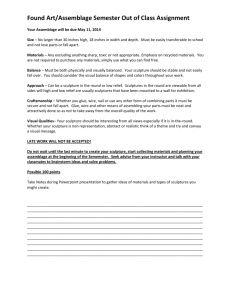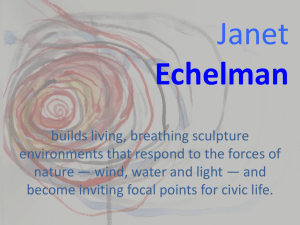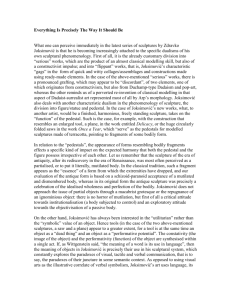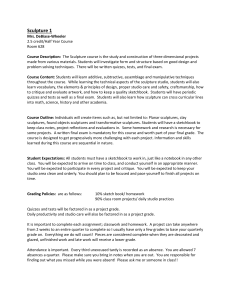Sculptures in the Park - Office of Superintendent of Public Instruction
advertisement
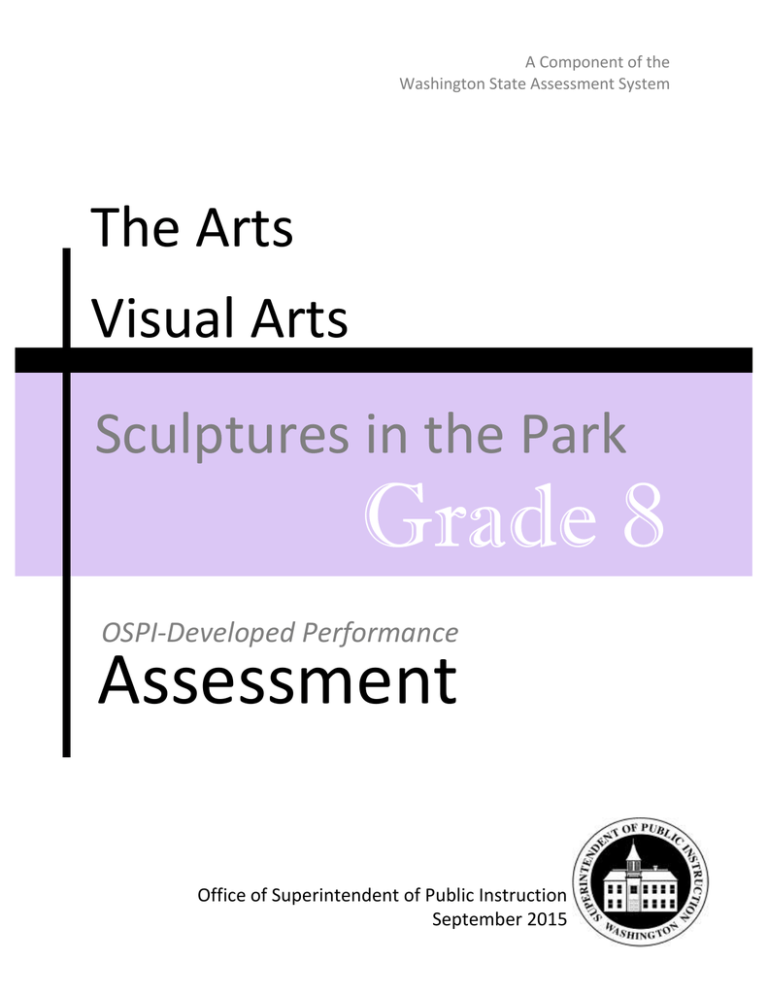
A Component of the Washington State Assessment System The Arts Visual Arts Sculptures in the Park Grade 8 OSPI-Developed Performance Assessment Office of Superintendent of Public Instruction September 2015 Office of Superintendent of Public Instruction Old Capitol Building P.O. Box 47200 Olympia, WA 98504-7200 For more information about the contents of this document, please contact: Anne Banks, The Arts Program Supervisor Phone: (360) 725-4966, TTY (360) 664-3631 OSPI provides equal access to all programs and services without discrimination based on sex, race, creed, religion, color, national origin, age, honorably discharged veteran or military status, sexual orientation including gender expression or identity, the presence of any sensory, mental, or physical disability, or the use of a trained dog guide or service animal by a person with a disability. Questions and complaints of alleged discrimination should be directed to the Equity and Civil Rights Director at (360) 725-6162 or P.O. Box 47200 Olympia, WA 98504-7200. This work is licensed as a Creative Commons Attribution Non-Commercial Share Alike product by the Washington Office of Superintendent of Public Instruction. For more information on this license, please visit http://creativecommons.org/licenses/by-nc-sa/3.0/. Table of Contents Introduction................................................................................................................................................... ii Overview ......................................................................................................................................................... 1 Test Administration: Expectations...................................................................................................... 1 Description of the Performance Assessment ................................................................................. 2 Learning Standards .................................................................................................................................... 2 Assessment Task ......................................................................................................................................... 3 Teacher’s Instructions to Students................................................................................................. 3 Accommodations .................................................................................................................................... 4 Student’s Task .......................................................................................................................................... 4 Supporting Materials and Resources for Teachers ................................................................... 12 Preparation for Administering the Assessment .................................................................... 12 Recommendations for Time Management ............................................................................... 14 Glossary ................................................................................................................................................... 16 Sculptures in the Park: Arts Assessment for Visual Arts, Grade 8 Page i OSPI-DEVELOPED PERFORMANCE ASSESSMENTS FOR THE ARTS Introduction To Washington educators who teach visual arts: Welcome to one of our OSPI-developed performance assessments and this implementation and scoring guide. This document is part of the Washington assessment system at the Office of Superintendent of Public Instruction (OSPI). The assessments have been developed by Washington State teachers and are designed to measure learning for selected components of the Washington State Learning Standards. They have been developed for students at the elementary and secondary levels. Teachers from across the state in small, medium, and large districts and in urban, suburban, and rural settings piloted these assessments in their classrooms. These assessments provide an opportunity for teachers to measure student skills; they can both help teachers determine if learning goals have been met, and influence how teachers organize their curricula. They also provide an opportunity for students to demonstrate the knowledge and skills they have gained. These assessments: Provide immediate information to teachers regarding how well their students have acquired the expected knowledge and skills in their subject areas. Inform future teaching practices. Provide resources that enable students to participate in measuring their achievements as part of the learning experience. Included in this document are: ▪ directions for administration ▪ assessment task ▪ scoring rubrics ▪ additional resources Our hope is that this assessment will be used as an integral part of your instruction to advance our common goal of ensuring quality instruction for all students. If you have questions about these assessments or suggestions for improvements, please contact: Anne Banks, Program Supervisor, The Arts (360) 725-4966, anne.banks@k12.wa.us Sculptures in the Park: Arts Assessment for Visual Arts, Grade 8 Page ii S CULPTURES IN THE P ARK An OSPI-Developed Performance Assessment Visual Arts Grade 8 Overview This document contains information essential to the administration of Sculptures in the Park, an OSPI-developed arts performance assessment for visual arts (Grade 8). Prior to administration of this assessment, all students should have received instruction in the skills and concepts being assessed. Please read this information carefully before administering the performance assessment. This classroom based performance assessment may be used in several ways: As an integral part of instruction. As a benchmark, interim, or summative assessment. As a culminating project. As an integral part of a unit of study. As a means of accumulating student learning data. Synopsis of Sculptures in the Park Each student creates a maquette of a visually balanced, abstract sculpture that portrays a kind of movement typically found in a park. The sculpture is to be sturdy, freestanding, and viewable from all sides. The name of the sculpture should reflect the movement it conveys. Students must also create diagrams that show how the shapes in their sculptures communicate their ideas of movement. As an individual student portfolio item. Test Administration: Expectations The skills assessed by this task should be authentically incorporated into classroom instruction. This assessment task is to be administered in a safe, appropriately supervised classroom environment following district policy and procedures. All industry and district safety policies and standards should be followed in the preparation and administration of OSPI-developed performance assessments in dance, music, theatre, and visual arts. Sculptures in the Park: Arts Assessment for Visual Arts, Grade 8 Page 1 Accommodations based upon a student’s individualized education program (IEP) or 504 Plan may require additional modifications to this assessment. Additional modifications to the administration of this assessment may be required to accommodate cultural differences, diversity, and religious mores/rules. Description of the Performance Assessment Performance prompts ask each student to design an abstract sculpture based on the criteria outlined in the prompt. The student must submit his/her design concept as a diagram/sketch and as a three dimensional representation (maquette) of the design. The teacher should collect all of the student’s work to facilitate scoring and to document each student’s performance. Students must also respond to short-answer questions and instructions. Their answers may be written or verbal. All written work must be completed on the response sheets provided. All verbal responses must be recorded to facilitate scoring and to document each student’s performance. Learning Standards This assessment addresses Washington State Learning Standards for Visual Arts, including the GLEs from the Options for Implementing the Arts Standards through Visual Arts by Grade Level document. GLE 1.1.1 Grades 7–8 Applies, analyzes, and creates the element line when producing a work of art. GLE 1.1.2 Applies, analyzes, and creates the elements shape and form when producing a work of art. GLE 1.1.3 Applies, analyzes, and creates the element value when producing a work of art. GLE 1.1.4 Applies, analyzes, and creates the element texture when producing a work of art. GLE 1.2.1 Analyzes and applies the skills and techniques of visual arts to create original works of art in two and/or three dimensions. Grades 7–8 Grades 7–8 Grades 7–8 Grades 7–8 GLE 2.1.1 Grades 7–8 Applies a creative process to visual arts. Sculptures in the Park: Arts Assessment for Visual Arts, Grade 8 Page 2 GLE 2.2.1 Grades 7–8 Applies a performance and/or presentation process to visual arts. GLE 2.3.1 Applies a responding process to a presentation/exhibit of visual arts. GLE 3.1.1 Analyzes the ways that visual arts are used to express feelings and present ideas and applies his/her understanding when creating artworks. GLE 3.2.1 Analyzes visual artworks that communicate for a specific purpose and applies his/her understanding when creating artworks. GLE 4.3.1 Analyzes and evaluates how visual arts impact state economic, political, and environmental choices. GLE 4.4.1 Analyzes and applies his/her understanding of how specific attributes of a visual artwork reflect and/or influence culture and history. GLE 4.5.1 Analyzes and applies understanding of how the knowledge, skills, and work habits of visual arts are needed and used in the world of work, including careers in visual arts. Grades 7–8 Grades 7–8 Grades 7–8 Grades 7–8 Grades 7–8 Grades 7–8 Depending on how individual teachers build their lesson units, additional Washington State Learning Standards can be addressed. Assessment Task Teacher’s Instructions to Students 1. Say: “Today you will take the Grade-8 Washington OSPI-developed arts performance assessment for visual arts. This assessment is called Sculptures in the Park.” 2. Provide the class with copies of the student’s section of the assessment (which may include the student’s task, response sheets, rubrics, templates, and glossary), along with any other required materials. 3. Tell the students that they may highlight and write on these materials during the assessment. Sculptures in the Park: Arts Assessment for Visual Arts, Grade 8 Page 3 4. Have the students read the directions to themselves as you read them aloud. We also encourage you to review the glossary and scoring rubrics with the students. 5. Answer any clarifying questions the students may have before you instruct them to begin. 6. If this assessment is used for reporting purposes, circle the scoring points on the first page of each student’s response sheets. Accommodations The following accommodations can be made for students with special needs or whose English language skills are limited: To complete the response sheets, students may dictate their answers to an instructional aide, who will write them down. The student may give the written and/or recorded responses in their first language. We request a written and/or verbal English translation for consistency (validity/reliability) in scoring the rubric. Refer also to the student’s individualized education program (IEP) or 504 Plan. Student’s Task The following section contains these materials for students: The student’s task: Sculptures in the Park (Grade 8) Assessment rubric Response sheets Sculptures in the Park: Arts Assessment for Visual Arts, Grade 8 Page 4 Student’s Task Sculptures in the Park Your community is going to open a new park. The park’s planners have asked that each student at your school design an abstract sculpture that conveys the idea of a kind of movement typically found in a park. The planners will select one of these designs and place the completed sculpture at the entrance of the new park. You would like your abstract sculpture to be selected as part of this new public park. To submit your design, you must create a preliminary diagram that illustrates how the shapes in your design will help communicate your particular idea of movement. You must also create a maquette of your sculpture. The maquette must be sturdy, freestanding, and viewable from all sides, and it must show visual balance. Finally, the planners would like you to name your abstract sculpture. The name should reflect the particular movement that you mean to convey in your sculpture. Your Task First, design your sculpture and create your maquette— The planners explain that you must meet the following requirements when creating your maquette: Identify the particular movement that you plan to represent in your abstract sculpture. In the composition of your sculpture, represent the theme of movement— specifically, a type of movement that is typical in a park, such as running, dancing, playing, trees swaying in the wind, leaves falling and flying in the wind, or kites flying. Draw a diagram that shows the free-form/organic and geometric shapes that you’ve chosen to help communicate your particular idea of movement and indicate how these shapes may be formed, connected, and assembled in your maquette. In your diagram, indicate the type of visual balance that you plan to use for the sculpture: formal/symmetrical, radial, or informal/asymmetrical. Cut shapes (geometric, free-form/organic) that support the theme of the specific movement that you have selected for your maquette. Use the materials provided. Sculptures in the Park: Arts Assessment for Visual Arts, Grade 8 Page 5 Assemble your shapes to create your stable, freestanding, abstract maquette. Use at least three different sculptural/construction techniques when creating your maquette, such as rolling or curling, twisting, bending or folding, scoring, slotting, and tabbing or gluing. Add at least two different textures to the surfaces of the maquette. Construct your maquette using the specific type of visual balance (formal/symmetrical, radial, or informal/asymmetrical) that you specified in your diagram to help you communicate the idea of movement. Second, show how you fulfilled the requirements of the planners— The planners explain that you must meet the following requirements when you respond to questions and prompts about your sculpture and the creation of the maquette: Name or give a title to your abstract sculpture and identify the movement that you chose to represent; explain how the name or title relates to the type of movement depicted by your maquette. Identify the parts of your maquette that are free-form/organic, geometric, or a combination of the two. Identify the two parts of the maquette that most effectively show the idea of movement and explain how each of these parts communicates the idea of movement. Identify and describe the different textures that you used on your maquette. Identify and describe the type of visual balance that you used in your maquette, and then justify your choice by explaining how that type of visual balance helps to communicate the idea of movement that you intended to represent in the maquette. Sculptures in the Park: Arts Assessment for Visual Arts, Grade 8 Page 6 Assessment Rubric Responding Creating Sculptures in the Park 4 points 3 points 2 points 1 point No Score The student meets four or five of the following requirements, thereby demonstrating a thorough understanding of sculptural form: Draws a diagram that indicates how the freeform/organic and geometric shapes that will be used in the sculpture might be shaped, connected, and assembled to communicate a particular idea of movement typical in a park. Uses at least three different sculptural or construction techniques when creating her/his sculpture, such as rolling or curling, twisting, bending or folding, scoring, cutting or slotting, and tabbing or gluing. Applies two or more different textures to the surface of the maquette. Assembles shapes to create a sturdy, stable, freestanding maquette of his/her abstract sculpture that helps communicate the appearance of the sculpture and the idea of movement. Creates a sculptural composition that represents— abstractly—the idea of a particular movement typical in a park. The student meets four or five of the following requirements, thereby demonstrating a thorough understanding of how to create an artwork to communicate for a selected purpose: Names or gives a title to an abstract maquette, identifies the movement, and explains how the title relates to the particular idea or type of movement depicted by the maquette. Identifies the parts of the maquette that are freeform/organic, geometric, or a combination of the two. Identifies the two parts of the maquette that most effectively show the idea of movement and explains how each of these parts communicates the idea of movement. Identifies two or more different textures that she/he applied to the surface of the maquette. Identifies and describes the type of visual balance used in the maquette and justifies the choice by describing how that type of balance helps to communicate the idea of movement. The student meets three of the requirements listed at left, demonstrating an adequate understanding of sculptural form. The student meets two of the requirements listed at left, demonstrating a partial understanding of sculptural form. The student meets one of the requirements listed at left demonstrating a minimal understanding of sculptural form. The student meets none of the requirements listed at left demonstrating no understanding of sculptural form. The student meets three of the requirements listed at left, demonstrating an adequate understanding of how to create an artwork to communicate for a selected purpose. The student meets two of the requirements listed at left, demonstrating a partial understanding of how to create an artwork to communicate for a selected purpose. The student meets one of the requirements listed at left, demonstrating a minimal understanding of how to create an artwork to communicate for a selected purpose. The student meets none of the requirements listed at left, demonstrating no understanding of how to create an artwork to communicate for a selected purpose. Sculptures in the Park: Arts Assessment for Visual Arts, Grade 8 Page 7 Response Sheets Student’s Name/ID# _____________________________________________ Grade Level _________ (circle number) Creating Score 4 3 2 1 NS Responding Score 4 3 2 1 NS Diagram and Maquette When designing your abstract sculpture, you must represent the idea of a particular movement typical in a park, such as running, dancing, playing, trees swaying in the wind, leaves falling and flying in the wind, or kites flying. Use the space provided on the next page to draw your diagram. You are not drawing the finished product in this space: You are drawing a plan that shows and explains how your cut shapes might fit together in your maquette and communicate your idea of movement typical in a park. Your diagram must indicate how your free-form/organic and geometric shapes might be shaped, connected, and assembled to help communicate (show) your chosen type or idea of movement. In your diagram, indicate the type of visual balance that you plan to use for the sculpture—formal/symmetrical, radial, or informal/asymmetrical. When you are finished with your diagram, cut and assemble your shapes to create your sturdy, stable, and freestanding maquette. Sculptures in the Park: Arts Assessment for Visual Arts, Grade 8 Page 8 Diagram Sculptures in the Park: Arts Assessment for Visual Arts, Grade 8 Page 9 Responses Respond to the following prompts to explain to the park’s planners how you met their requirements when you created your diagram and maquette. 1. Give a name or title to your abstract sculpture and explain how this name or title relates to the particular idea or type of movement depicted by your maquette. name/title: _________________________________________________________________________________ explanation: ________________________________________________________________________________ _____________________________________________________________________________________________ _____________________________________________________________________________________________ 2. Identify the parts of your maquette that are free-form/organic, geometric, or a combination of the two: free-form/organic: _________________________________________________________________________ _____________________________________________________________________________________________ geometric: _________________________________________________________________________________ ____________________________________________________________________________________________ combination: _______________________________________________________________________________ ____________________________________________________________________________________________ 3. Identify and describe the two parts of the maquette that most effectively show your particular idea of movement and explain how each of these parts communicates your chosen type or idea of movement: first part: ___________________________________________________________________________________ explanation: ________________________________________________________________________________ _____________________________________________________________________________________________ _____________________________________________________________________________________________ second part: ________________________________________________________________________________ explanation: ________________________________________________________________________________ _____________________________________________________________________________________________ _____________________________________________________________________________________________ Sculptures in the Park: Arts Assessment for Visual Arts, Grade 8 Page 10 4. Identify and describe the different textures that you used on your maquette. _____________________________________________________________________________________________ _____________________________________________________________________________________________ _____________________________________________________________________________________________ _____________________________________________________________________________________________ _____________________________________________________________________________________________ 5. Identify and describe the type of visual balance that you used in your maquette (such as formal/symmetrical, radial, and/or informal/asymmetrical). _____________________________________________________________________________________________ _____________________________________________________________________________________________ _____________________________________________________________________________________________ _____________________________________________________________________________________________ _____________________________________________________________________________________________ 6. Justify your choice by explaining how that type of balance helps to communicate the particular idea of movement that you chose for your maquette. _____________________________________________________________________________________________ _____________________________________________________________________________________________ _____________________________________________________________________________________________ _____________________________________________________________________________________________ _____________________________________________________________________________________________ Sculptures in the Park: Arts Assessment for Visual Arts, Grade 8 Page 11 Supporting Materials and Resources for Teachers Preparation for Administering the Assessment Tools & Materials Teachers will need the following materials and resources to administer this performance assessment: copies of the task, including the glossary of terms (one set for each student) copies of the student-response sheets (one set for each student) sketch paper for each student (to be used for planning the design of the sculpture) 1/8th sheet of poster board (approximately 11″ x 7″), heavy weight tag board, or other stiff and bendable clean board that is one or two colors and free of printing (to be used for making a maquette) pencils scissors or other cutting tools glue (fast drying glue works best for this project) tape (for temporary attachment) rulers, compasses optional materials: French curves, actual textural materials (fabric, textured papers, beads, etc.) a camera (if the teacher intends to take photographs of the students’ work) audio and/or video recording equipment (if needed for individual students) Note: If necessary, students may use glue to ensure stability and to reinforce the joints of the sculpture after assembly. Tape must be removed from the final maquette. No base is necessary as the sculpture is freestanding. Guidelines This assessment is an individual performance. Copy the student’s task, glossary of terms, and response sheets. Make one set of copies for each student. Gather sketch paper, construction materials, and tools. Sculptures in the Park: Arts Assessment for Visual Arts, Grade 8 Page 12 If you take photographs for use in the student’s portfolio and to document the student’s work, the photographs should show the sculpture from at least four possible angles, such as front, back, right side, left side, and bird’s-eye view. These views must be labeled for clear identification, scoring, and so on. The images should also show sketches and final drawings. Be sure to include the student’s name and number with each photograph. Students who respond in writing must include their names/numbers on their response sheets. If necessary to meet individual needs, a student may dictate her/his response-sheet answers (to be written down by a teacher or aide). Students may use resources that are visible in the testing classroom, but you may not prompt or coach students during the assessment. As an alternative to a written response, you may permit video or audio recording. Video set up should be in a defined space so that the speaker can be seen at all times. Coach the students who are being recorded to face the recording device when they are responding. Prompt students to say their names, numbers, and current grade level into the recording device before beginning the performance. Students must have a copy of the response sheet when they are being recorded. The teacher’s role during recording is to read questions. Students may use resources that are visible in the testing classroom, but you may not prompt or coach students during the assessment. When you are administering the assessment, students may ask questions to clarify the process. You should encourage students to ask questions at any time throughout the administration of the assessment. Sculptures in the Park: Arts Assessment for Visual Arts, Grade 8 Page 13 Recommendations for Time Management Students may have as much time as they need to complete the task. The timeframes suggested here are meant only as a guide, and you may shorten or lengthen them to suit the individual circumstances of the class and students. The following is a four-day suggested timeframe: DAY 1 15 minutes: The teacher provides the class with the task and reads it aloud. The students may ask questions. The teacher answers any questions and distributes all materials. 25 minutes: Each student creates a diagram. Some students may then begin their maquettes. 5 minutes: The teacher collects all materials (including sketches and maquettes). DAY 2 5–10 minutes: The teacher returns all materials and reviews the prompt. 35 minutes: The students continue to work on their maquettes. 5 minutes: The teacher collects all materials. DAY 3 5 minutes: The teacher returns all materials and distributes response sheets. 35 minutes: The students complete their maquettes and begin to work on their response sheets. 5 minutes: The teacher collects all materials and response sheets DAY 4 5 minutes: The teacher returns all materials and response sheets. 30 minutes: The students complete their maquettes and written response sheets; the teacher records (or otherwise accommodates the needs of) students who respond verbally. 5 minutes: The teacher collects all materials and finished maquettes.* *Note: Prior to the collection of the sculptures, you may want to photograph them (with or without the students) in order to document achievement for all of the purposes of this assessment. Sculptures in the Park: Arts Assessment for Visual Arts, Grade 8 Page 14 All students who remain productively engaged in the task should be allowed to finish their work. In some cases, a few students may require considerably more time to complete the task than most students; therefore, you may wish to move these students to a new location to finish. In other cases, the teacher’s knowledge of some students’ work habits or special needs may suggest that students who work very slowly should be tested separately or grouped with similar students for the test. Sculptures in the Park: Arts Assessment for Visual Arts, Grade 8 Page 15 Glossary abstract art—1. a style of art that refers to various types of 20th-century avantgarde art; 2. abstract also refers to images that have been altered from their realistic/natural appearance: they have been simplified to their basic contours/forms; 3. abstract art is often based upon a recognizable object, which is then simplified to show some purer underlying shape or form, sometimes removing any references to recognizable objects. balance—a principle of design of visual arts; the arrangement of elements that makes individual parts of a composition appear equally important; balance is an arrangement of the elements to create an equal distribution of visual weight throughout the format, sculpture, or composition. Types of balance include: asymmetrical/informal balance—balance that results when two sides of an artwork are equally important, but one side looks different from the other; not equally arranged on opposite sides of a center line or center point, but in overall harmony or equilibrium. symmetrical/formal balance—an image or form equally weighted on both sides of a center dividing line or plane. radial balance—an image or form that is equally symmetrical and radiating from a center point throughout. form—an element of visual arts; a three-dimensional object that has height, width, and depth. free form—a shape or form having an asymmetrical or irregular contour, often with a curvilinear, flowing outline; sometimes referred to as organic or biomorphic, but may also include angles. freestanding—stands on its own; self-supporting. geometric—any shapes and/or forms based on mathematical principles, such as a square/cube, circle/sphere, and triangle/cone or pyramid. maquette—a small-scale two-dimensional sketch or a three-dimensional model or plan of a proposed work, such as a sculpture or architectural form; used by architects and sculptors when designing large-scale works. movement—a principle of design of visual arts that creates the suggestion of motion in a work of art such as a sculpture, drawing, or painting; the use of particular elements of art to draw a viewer’s eye through an artwork. sculpture—a three-dimensional work of art. Sculptures in the Park: Arts Assessment for Visual Arts, Grade 8 Page 16 sculptural techniques—different ways to create 3-D forms, such as cutting, folding, rolling, twisting, curling, scoring, bending, attaching, joining, and carving; using additive and subtractive processes to create three dimensional works of art. shape—an element of art; a two-dimensional (flat) area enclosed by a line: geometric—any shapes and/or forms based on mathematical principles, such as a square/cube, circle/sphere, and triangle/cone or pyramid. organic—shapes and/or forms similar to those found in nature, such as plants, animals, and rocks; often curvilinear in appearance. technique—methods of working with particular materials to create an artwork. texture—an element of visual arts; portrays surface quality; how something feels or appears to feel; some drawing techniques for creating texture and patterns are stippling, hatching, cross-hatching, scribbling, broken lines, and repeating lines and shapes. Types include: actual texture—how something actually feels when touched. visual texture—how something appears to feel; also called simulated texture or implied texture. three-dimensional or 3-D—having actual height, width and depth and existing in three dimensional space; or having the illusion of existing in three dimensions. Sculptures in the Park: Arts Assessment for Visual Arts, Grade 8 Page 17

